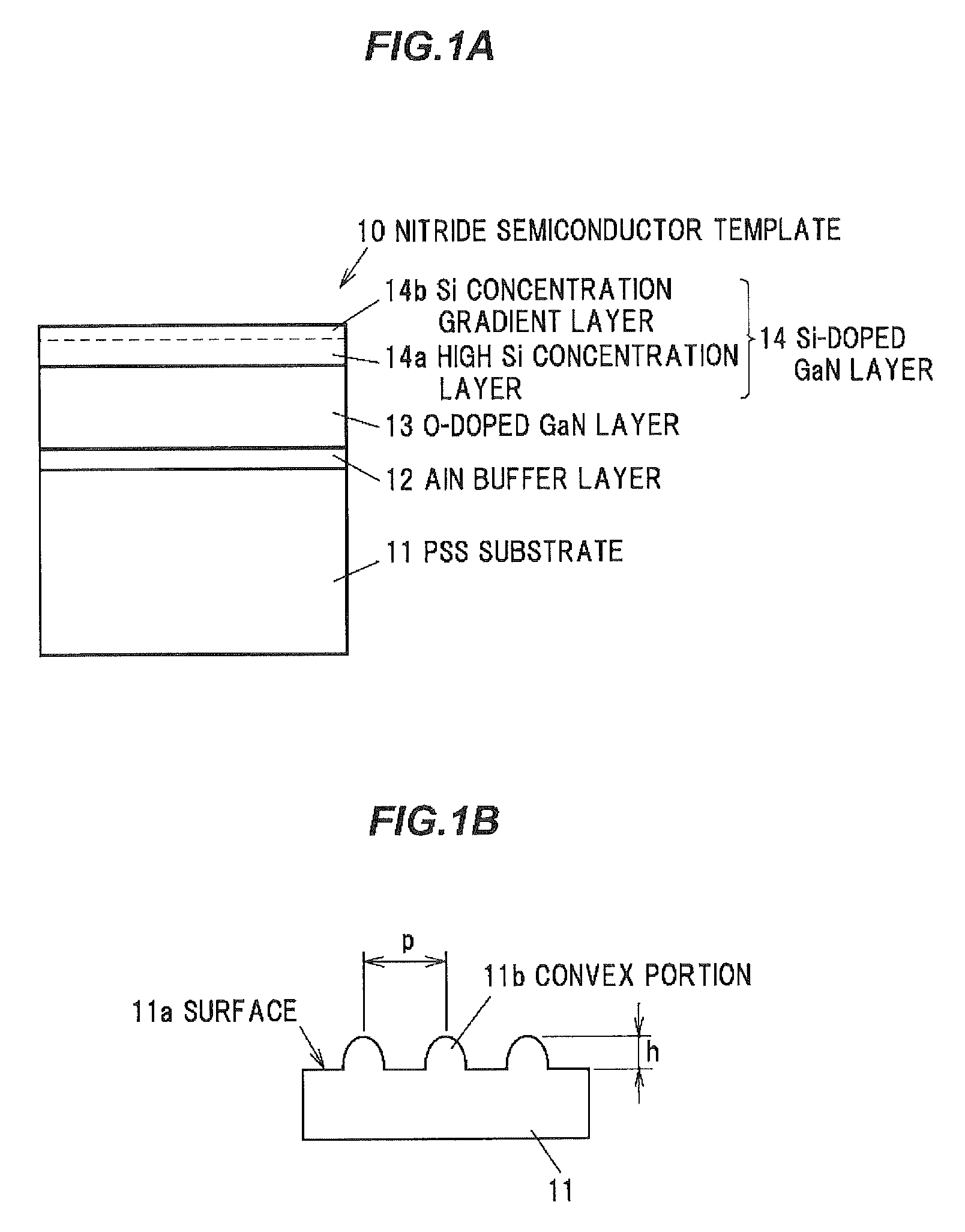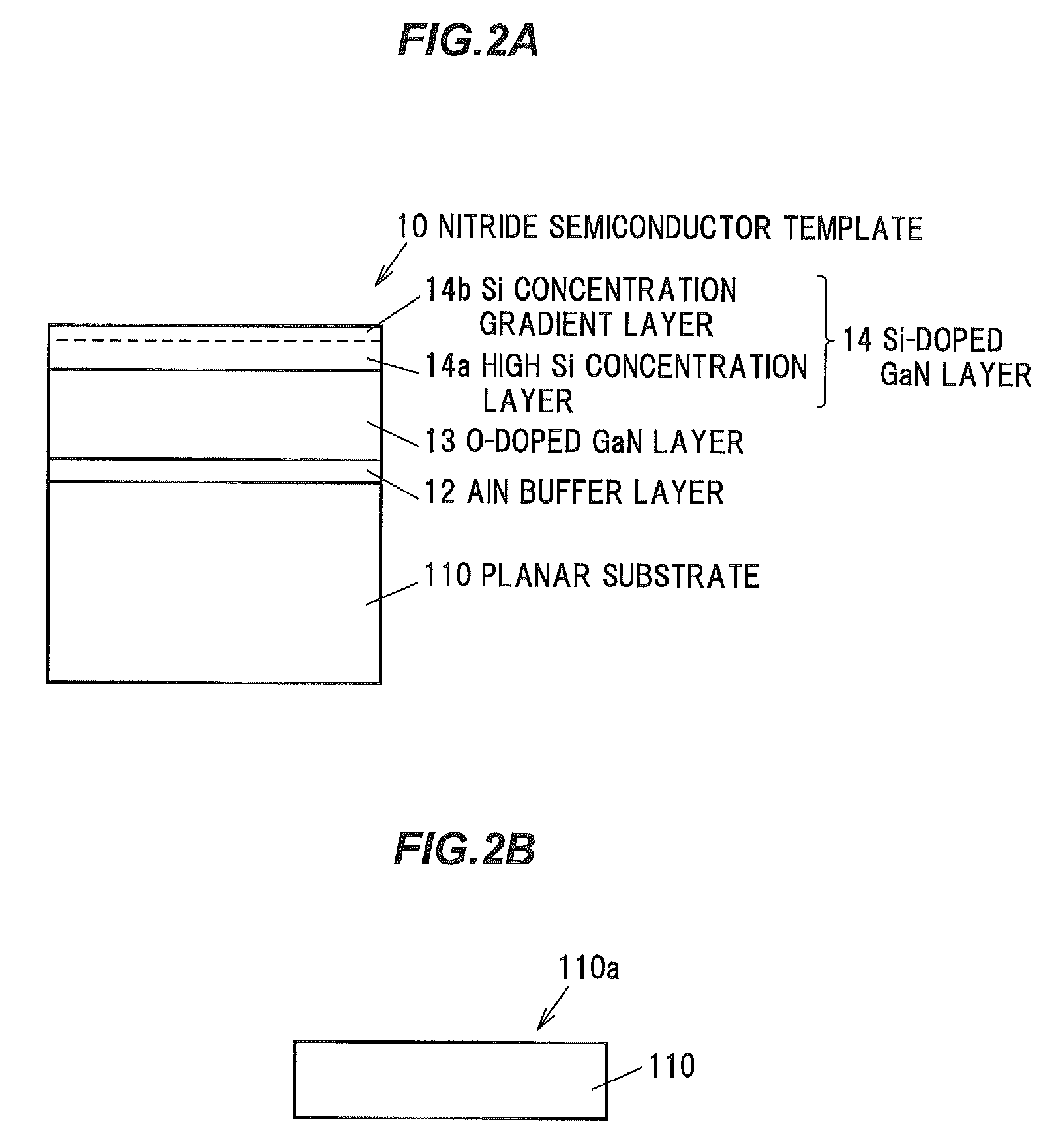Nitride semiconductor template and light-emitting diode
a semiconductor and template technology, applied in semiconductor/solid-state device manufacturing, semiconductor devices, electrical devices, etc., can solve the problems of reducing reliability, reducing reliability, and reducing brightness of light-emitting diodes, and achieves low resistance, good crystalline characteristics, and low resistance.
- Summary
- Abstract
- Description
- Claims
- Application Information
AI Technical Summary
Benefits of technology
Problems solved by technology
Method used
Image
Examples
example 1
[0106]FIG. 5 is a schematic view showing a structural example of an HVPE apparatus in Examples of the invention. In Example 1, 20 nm of the AlN buffer layer 12 was grown on the PSS substrate 11 using an HVPE apparatus 1 shown in FIG. 5, 6 μm of the O-doped GaN layer 13 was subsequently grown after the growth of the AlN buffer layer 12, and 2 μm of the Si-doped GaN layer 14 was further grown thereon. 0.5 μm of the outermost layer of the Si-doped GaN layer 14 was grown while changing the additive amount of Si. The layer formed while gradually reducing the additive amount of Si is the Si concentration gradient layer 14b. The HVPE apparatus 1 is divided into a raw material portion 3a located at upstream and a growth portion 3b located at downstream, which are respectively heated to about 850° C. and 1100° C. respectively by a raw material portion heater 4a and a growth portion heater 4b.
[0107]Four gas supply lines 6, which are a doping line 61, a group V line 62, a group III (Ga) line ...
example 2
[0133]In Example 2, the nitride semiconductor template 10 was made under the same basal conditions as Example 1. However, some features in Example 2 are different from Example 1. Accordingly, only the difference from Example 1 will be described blow.
[0134]In Example 1, the O-doped GaN layer 13 was grown for growth time of 10 minutes so as to have a thickness of about 6 μm. Meanwhile, in Example 2, the O-doped GaN layer 13 was grown for growth time of 13 minutes so as to have a film thickness of about 8 μm. Accordingly, the total film thickness of the epitaxial layer was about 10 μm.
[0135]In addition, the gas supplied through the group III (Ga) line 63 was a mixture of 50 sccm of HCl gas, 450 sccm of hydrogen and 2000 sccm of nitrogen in Example 1 but was a mixture of 2000 sccm of hydrogen and 450 sccm of nitrogen in Example 2.
[0136]The nitride semiconductor template 10 in Example 2 had a narrow XRD half-value width of 50.1 seconds and surface resistivity of 11 Ω / sq, hence, a better ...
example 3
[0138]In Example 3, the nitride semiconductor template 10 was made under substantially the same conditions as those in Example 1 so that the carrier concentration on the outermost surface of the Si concentration gradient layer 14b is 5×1017 cm−3. The nitride semiconductor template 10 in Example 3 had a narrow XRD half-value width of 74.5 seconds and surface resistivity of 15 Ω / sq. The 34 mW of light emission output was achieved and relative output was 99.7%, and therefore, it was confirmed that the blue LED element 30 has sufficient reliability characteristics.
PUM
| Property | Measurement | Unit |
|---|---|---|
| thickness | aaaaa | aaaaa |
| thickness | aaaaa | aaaaa |
| carrier concentration | aaaaa | aaaaa |
Abstract
Description
Claims
Application Information
 Login to View More
Login to View More - R&D
- Intellectual Property
- Life Sciences
- Materials
- Tech Scout
- Unparalleled Data Quality
- Higher Quality Content
- 60% Fewer Hallucinations
Browse by: Latest US Patents, China's latest patents, Technical Efficacy Thesaurus, Application Domain, Technology Topic, Popular Technical Reports.
© 2025 PatSnap. All rights reserved.Legal|Privacy policy|Modern Slavery Act Transparency Statement|Sitemap|About US| Contact US: help@patsnap.com



